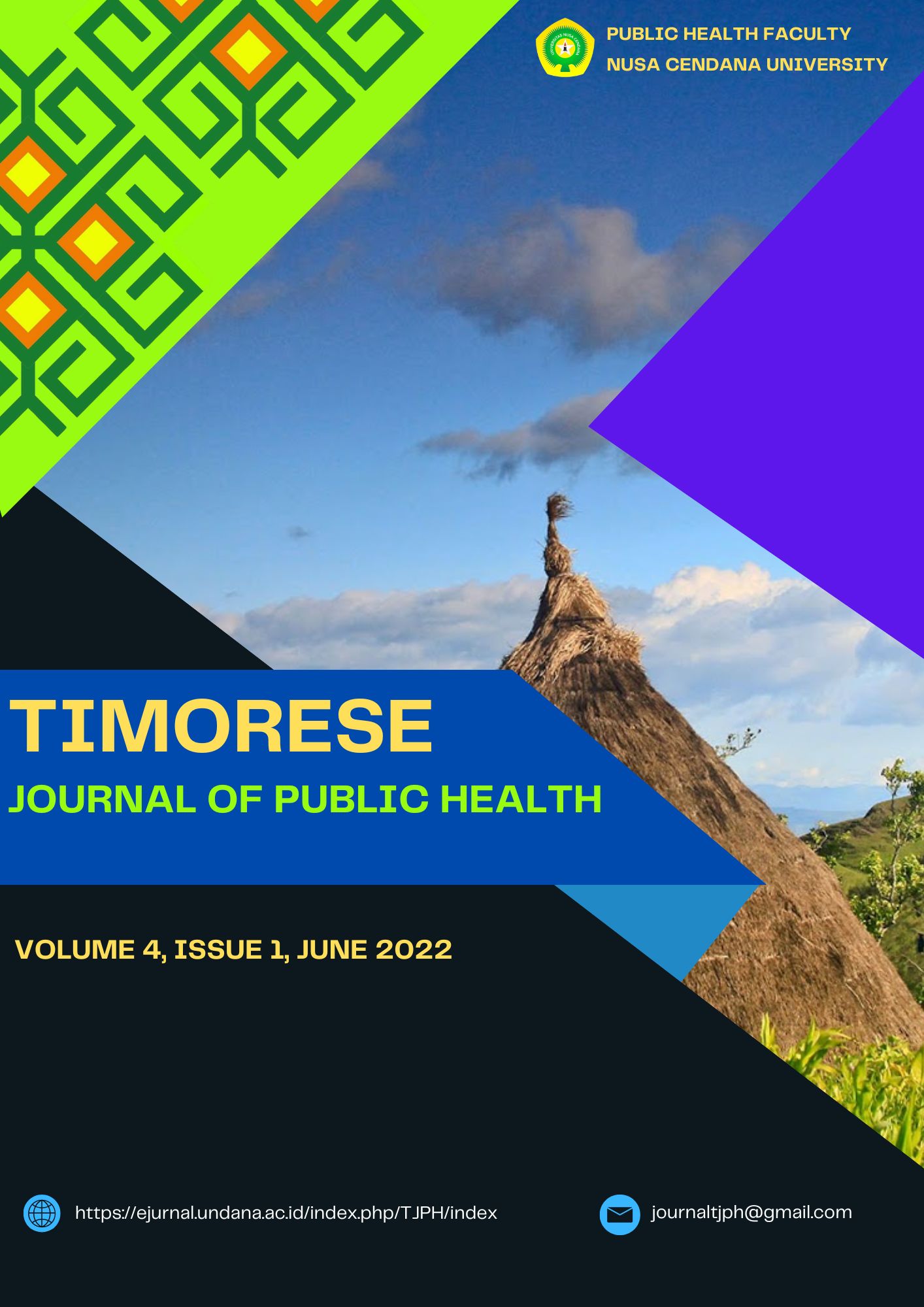Factors Associated Between Food Consumption Patterns and Nutritional Status of Toddlers Aged 3-5 Years in Tarus Health Center, Kupang Regency
Main Article Content
Abstract
According to data from the Tarus Health Center in 2021, 47 toddlers under five are malnourished, 170 toddlers are malnourished, 57 toddlers are at risk of overnutrition, 20 toddlers are malnourished, and four are obese. This study aims to determine the relationship between food consumption patterns and the nutritional status of children aged 3-5 years at the Tarus Public Health Center, Kupang Regency. An across-sectional research design was used in the form of an analytic observational study. The population in this study were all children aged 3-5 years who were in the Work Area of the Tarus Health Center as many as 419 toddlers. The research sample amounted to 100 people. The sampling technique in this study using the proportional stratification random sampling technique is a sampling process by dividing the population into strata, selecting random samples from each stratum, and combining them to estimate population parameters. A Chi-Square test was performed to analyze the data. The findings showed that the type of food (p = 0.000), energy adequacy (p = 0.034), and protein adequacy (p = 0.011) were all related to the nutritional status of children under five. While the frequency of unhealthy eating is not related to nutritional status (p = 0.090), it is recommended that health workers carry out more nutrition-aware family counseling, especially to parents whose toddlers have low, less, or more nutritional status, so that nutritional status can be managed effectively
Downloads
Article Details
References
2. Almatsier S. Prinsip Dasar Ilmu Gizi. Jakarta: PT. Gramedia Pustaka; 2009. 9–12 p.
3. Waladow G, Warouw SM, Rottie J V. Hubungan Pola Makan dengan Status Gizi Pada Anak Usia 3-5 Tahun di Wilayah Kerja Puskesmas Tompaso Kecamatan Tompaso. ejournal keperawatan (e-Kp) [Internet]. 2013;1(1):1–6. Available from: https://media.neliti.com/media/publications/105788-ID-hubungan-pola-makan-dengan-status-gizi-p.pdf
4. Riskesdas. Badan Penelitian dan Pengembangan Kesehatan Kementrian RI [Internet]. Jakarta: Kementrian RI; 2018. Available from: https://kesmas.kemkes.go.id/assets/upload/dir_519d41d8cd98f00/files/hasil-riskesdas-2018_1274.pdf pada tanggal 20 Agustus 2020
5. Puskesmas Tarus. Data Status Gizi Balita di Puskesmas Tarus Tahun 2020. Kota Kupang: Puskesmas Tarus; 2020.
6. Puskesmas Tarus. Data Status Gizi Balita di Puskesmas Tarus Tahun 2019. Kota Kupang: Puskesmas Tarus; 2019.
7. Putri Hasanbuan, Siagian S. Hubungan Pola Konsumsi Makan dengan Status Gizi Balita di Lingkungan VII Kelurahan Sitorejo Kecamatan Medan Tembung. J Kebidanan Kestra [Internet]. 2020;2(2):116–25. Available from: https://ejournal.medistra.ac.id/index.php/JKK/article/view/229
8. Sulistyoningsih. Gizi Untuk Kesehatan Ibu dan Anak. Yogyakarta: Graha Ilmu; 2011.
9. Stefani Oktavia Sitompul, Yoseph Leonardo Samodra IK. Hubungan Pola Makan Anak dengan Status Gizi Siswa TK Bopkri Gondokusuman Yogyakarta. Indones J Nurs Heal Sci [Internet]. 2020;5(2):126–33. Available from: Sitompul, S. (2020). Hubungan Pola Makan Anak dengan Status Gizi Siswa TK Bopkri Gondokusuman Yogyakarta. Indonesian Journal of Nursing Health Science.
10. Nasution, H. S., Siagian, M., & Sibagariang EE. Hubungan Pola Makan dengan Status Gizi pada Anak Balita di Wilayah Kerja Puskesmas Medan Sunggal di Lingkungan XIII Kelurahan Sunggal Kecamatan Medan Sunggal Tahun 2018. J Kesehat Masy dan Lingkung Hidup [Internet]. 2018;40(2):63–69. Available from: http://e-journal.sari-mutiara.ac.id/index.php/Kesehatan_Masyarakat/article/view/473
11. Suzanna, Budiastutik, I., & Marlenywati M. Analisis Faktor Yang Berhubungan Dengan Status Gizi Anak Usia 6-59 Bulan. J Vokasi Kesehat. 2017;3(1):35.
12. Anzarkusuma I.S., Mulyani E.Y., Jus’at I. AD. Status Gizi Berdasarkan Pola Makan Anak Sekolah Dasar di Kecamatan Rajeg Tangerang. Indones J Hum Nutr [Internet]. 2014;1(2):135–48. Available from: https://ijhn.ub.ac.id/index.php/ijhn/article/view/109
13. Septikasari M. Status Gizi Anak dan Faktor yang Mempengaruhi. Pertama. Yogyakarta: UNY Press; 2018.
14. Utami HD, Siregar A, Gizi PS, Kesehatan P, Bengkulu K. Hubungan Pola Makan , Tingkat Kecukupan Energi , dan Protein dengan Status Gizi pada Remaja Relationship between Eating Pattern , Energy and Protein Adequacy Level with Nutritional Status in Adolescent. J Kesehat [Internet]. 2020;11(2):279–86. Available from: https://ejurnal.poltekkes-tjk.ac.id/index.php/JK/article/download/2051/1157

